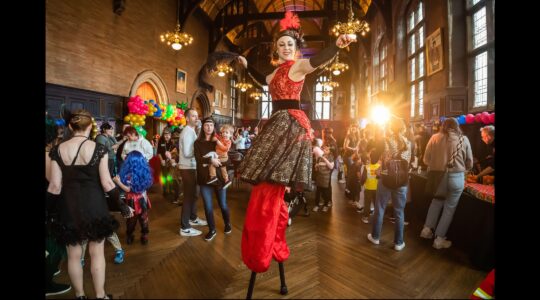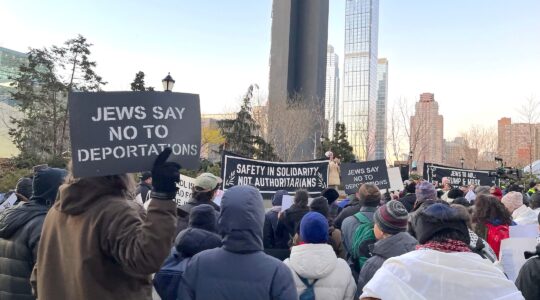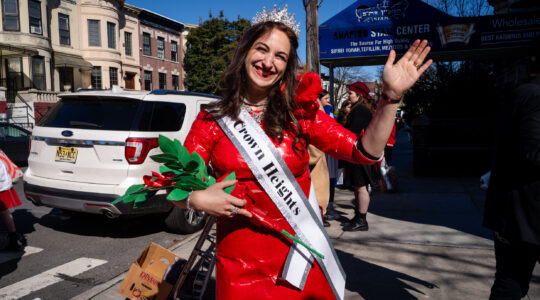Liat Bartal is a Jewish Israeli from Givataym, near Tel Aviv. Mother Xavier is a Christian nun at Tyburn Convent in London, England. Ayse Yegul is a Muslim from Turkey now living in Toronto, Canada. These women have never met, but they have something in common: All three are participants in a creative project that has engaged more than 1,400 people of different faiths from around the world in cross-stitching the Torah.
Run exclusively by volunteers who have devoted 130,000 hours of unpaid labor in the last six years, the Torah Stitch by Stitch project is now close to completion. The first half of the enormous tapestry is made from joining individual four-verse panels and illuminations stitched by participants. It is on display until November 17 in an exhibition titled, “Tapestry of Spirit” at the Textile Museum of Canada in Toronto.
The project’s organizers hope to finish the entire tapestry within the next two years, and to establish partnerships enabling it to be shown in other locations worldwide. Upon completion, the stitched Torah will include some 2,000 individual Hebrew text and illumination panels. It will stand over two meters (seven feet) high and will be almost as long as an American football field (approximately 91 meters, or 300 feet).
When Toronto Judaica artist and art educator Temma Gentles founded the The Torah Stitch by Stitch project in June 2013, she had no intention for it to grow as large as it has.
“I envisioned it as a limited educational project of engagement with Judaism that I would lead while I was artist in residence at Holy Blossom Temple in 2013,” Gentles told The Times of Israel.
Gentles, 73, had been thinking about how people might want to express how Judaism “permeates their being,” and after considering several artistic approaches, she settled on cross-stitching.
As someone experienced with calligraphy, she liked how cross-stitching could focus on the form of the Hebrew letters of the Torah. She also appreciated the historical background of cross-stitching as a folk art associated for centuries with women of many cultures.
“I never had any pretense of finishing the entire Torah or having an exhibition. But the project took off on a global scale after Hadassah Magazine published a blurb on it in 2013,” said Gentles, who became the project’s creative director.
According to Torah Stitch by Stitch president and chair Lili Shain, 65, people of many faiths — and no faith — from 28 countries reached out asking to stitch panels. The majority were from North America, but there were also many from other parts of the world, including Japan, Guatemala, South Africa, Spain, England, and the Philippines. Most of the stitchers were women, but some were men, and ranged in age from teenagers to nonagenarians. In some families, stitching the panels became a shared multigenerational activity.
Bartal, a Hebrew teacher, is one of some 30 stitchers in Israel. Like all participants, she paid $18 for a mailed kit containing all the necessary materials, including needle, threads, fabric panel, and pattern for the assigned four Torah verses (only the first of the project’s stitchers had their choice of verses). Stitchers were encouraged to illuminate, or embellish their panels with borders or illustrations. For those seeking inspiration, the organizers provided sample designs created by Gentles and other artists.
Bartal, 40, had no serious experience with cross-stitching, but that did not matter. “We had no means test in terms of prior skill,” said Gentles.
“I had just done some stitching for fun when I was traveling in India 20 years ago,” Bartal said. Yet, the idea of joining with hundreds around the world and using the opportunity as a way of connecting with her Jewish heritage in a different way encouraged her to stick with the task for the nearly two months it took her to complete her four verses. (According to Torah Stitch by Stitch president Shain, it took individuals between 50 and 100 hours on average to complete their panels, depending on the length of the verses and the complexity of the added illuminations.)
Bartal, who described herself as not religious, was assigned a section from the book of Numbers. The book’s Hebrew name is BaMidbar, which means “in the desert.” It was a fitting selection for Bartal, who stitched her verses while helping to care for her sister’s newborn baby girl at her sister’s home in Mitzpe Ramon in Israel’s Negev desert.
“I sat there stitching like an old auntie,” Bartal joked.
She chose to illuminate her panel with an image of a tree from the desert. While praised the project for bringing so many people together, she also liked that it will forever have a personal meaning. “Those four stitched verses will always remind me of my new niece,” she said.
Bartal was fortunate to have met Torah Stitch by Stitch’s Shain while the latter was on an extended visit to Israel. Shain introduced Bartal to the project and taught her how to properly cross-stitch. The project’s organizers arranged for seasoned stitchers to instruct and mentor newbies, either in person or virtually, and individually or in groups.
Longtime Jerusalem resident Sharon Binder is an artist, designer and calligrapher. Binder, 71, was one of those Gentles consulted with as she tried to decide on the specific Hebrew font to be used (it had to have a geometric nature and lend itself to the pixelation effect of the cross-stitch).
Binder does embroidery. However, she initially found learning cross-stitch a challenge. “A friend in her 90s showed me how to do it. There is a technique to it. It took me three times to get it going properly. You need to be very careful with counting,” Binder said.
Even more difficult was figuring out how to create the illusion of movement in the abstract illumination Binder designed herself for the verses in Genesis recounting the creation of the first and second days. She had to do it using only the seven approved thread colors.
“I ended up combining threads together to create variations of colors,” she explained.
While stitchers of individual panels faced obstacles, the biggest challenge fell to a team of 20 volunteers who toiled tirelessly to back and sew together by hand all the 2,000 panels to create the final product. The panels are sewn into columns and then into units (three columns per unit). Each column must have exactly 1,092 squares (one “square” is a single cross-stitch, with 14 squares per one inch.) Not all panels are the same length, so illumination panels must be used to fill in the gaps to create units of uniform length.
This painstaking endeavor is mainly the responsibility of 73-year-old Pat Little, who volunteered to lead this assembly team, which usually gathers at Little’s Toronto home.
“The work often has to be pulled apart and redone. It’s an exercise in patience,” said Little, who is Christian and married to a Jewish man.
The exhibition of the partially completed tapestry moved Little to tears.
“I was overwhelmed and cried when I saw it mounted at the museum. I was amazed that we had done it. It was so meaningful, especially since I know the personal stories of so many of the stitchers,” she said.
Indeed, Gentles said that the panels “went on life journeys with people.” For instance, some stitched them while in the hospital. Some terminally ill individuals held on until they could finish their panels.
Binder said she loved the contemplative nature of breaking down the Torah’s letters into tiny squares, while at the same time zooming out to gain a new perspective on the Torah as a whole through this particular art form. In fact, the way the exhibition is set up enhances the feeling of literally standing inside the Torah. The tapestry is mounted on a structure specially designed by Martin Gaudet that conveys the curvature and fluidity of a scroll, which can be free-standing or attached to gallery walls.
“It’s visceral and potent for people to be among the words of Torah,” Gentles said.
Although the Torah Stitch by Stitch organizers are committed to making sure that every single letter and word is correct, and the presentation of the work mimics the Torah scroll’s form, Gentles was quick to note that it is a piece of folk art — and not a real Torah in any way. (Nonetheless, Gentles had several oversize wooden yads [Torah pointers] for museum docents to use for touching the tapestry, just as would be done in touching a real Torah.)
“We had the project vetted by several Orthodox rabbis in North America and Israel and they were fine with it,” Gentles said.
Shain mentioned that Orthodox participants were uncomfortable with stitching the name of God. They were assigned verses that did not have God’s name in them.
The stitchers were familiar with the Hebrew letters to varying degrees. For 73-year-old Janice Rock, a Christian woman from Oakville near Toronto, it was an exciting opportunity to learn more about the Hebrew alphabet. Working on Torah Stitch by Stitch led her to read books on the mystical aspects of the Hebrew alphabet, such as “The Book of Letters: A Mystical Hebrew Alphabet” by Rabbi Lawrence Kushner.
“Lamed is my favorite letter. I like its shape. And when I went back to my panel, it turned out that the first letter I stitched was lamed!” Rock said excitedly.
The project also includes two smaller tapestries, one with surahs from the Quran and one with verses from the New Testament. Both texts refer to creation. “All three faiths share the creation story. We picked a commonality,” Shain said.
Although the Torah — in Hebrew — is the primary focus of the project, it has drawn a large and diverse audience to see it at the Textile Museum of Canada, according to museum director Emma Quin.
“It’s a mammoth project and incredibly powerful. Although we have handmade items in our collection, I hadn’t before seen anything quite like this. It is a testament to the power of the global maker community,” Quin said.
In a short film made about Torah Stitch by Stitch that plays on a loop at the museum exhibition, stitcher Yegul from Turkey said that the project is timely.
“I really believe that people when they come together for a purpose, they do something together. In this world, especially in these times, it’s really important for people to know each other — because if you don’t know, you have fear,” she said.
“I’m very grateful to have the roots of my religion in the Torah,” Mother Xavier said in the film.
“The whole world is just getting so full of violence and anger… All these women are getting together that don’t even know one another, and here they are sitting down peacefully and putting their stitches in stitch by stitch,” she said.
The New York Jewish Week brings you the stories behind the headlines, keeping you connected to Jewish life in New York. Help sustain the reporting you trust by donating today.




